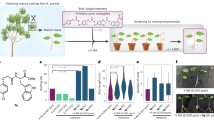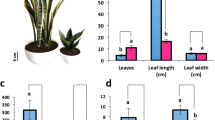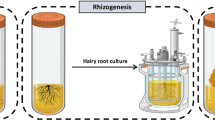Abstract
For some years, there has been great interest in the exploitation of plant cell cultures to produce fine chemicals. With a few exceptions, progress in commercialization has been slow, largely due to the low and/or unstable productivity of many undifferentiated cultures. Recent developments leading to the production of rapidly growing, organized, ‘hairy’ root cultures following the genetic transformation of plants with Agrobacterium rhizogenes may revolutionize certain areas of plant cell biotechnology. We discuss the application of hairy root technology to the production of plant secondary metabolites.
This is a preview of subscription content, access via your institution
Access options
Subscribe to this journal
Receive 12 print issues and online access
$209.00 per year
only $17.42 per issue
Buy this article
- Purchase on Springer Link
- Instant access to full article PDF
Prices may be subject to local taxes which are calculated during checkout
Similar content being viewed by others
References
Tabata, M. and Fujita, Y. 1985. Production of shikonin by plant cell cultures, p. 207–218. In: Biotechnology in Plant Science. Zaitlin, M., Day, P. and Hollaender, A. (Eds.). Academic Press, New York.
Kurz, W.G.W. and Constabel, F. 1979. Plant cell cultures, a potential source of pharmaceuticals. Adv. Appl. Microbiol. 25: 209–240.
Zenk, M.H. 1978. The impact of plant cell cultures on industry, p. 1–13. In: Frontiers of Plant Tissue Culture 1978. Thorpe, T. A. (Ed.). University of Calgary Press, Alberta.
Zenk, M.H., El-Shagi, H., Arens, H., Stöckigt, J., Weiler, E.W., and Deus, B. 1977. Formation of the indole alkaloids serpentine and ajmalicine in cell suspension cultures of Catharanthus roseus, p. 27–43. In: Plant Tissue Culture and its Bio-technological Application. Barz, W., Reinhard, E., and Zenk, M. H. (Eds.). Springer-Verlag, Heidelberg.
Fujita, Y., Takahashi, S., and Yamada, Y. 1984. Selection of cell lines with high productivity of shikonin derivatives through protoplast of Lithospermum erythrorhizon . Proceedings, 3rd European Conference on Biotechnology 1: 161–166.
Deus-Neumann, B. and Zenk, M.H. 1984. Instability of indole alkaloid production in Catharanthus roseus cell suspension cultures. Planta Medica 50: 427–431.
Flores, H.E. and Filner, P. 1985. Metabolic relationships of putrescine, GABA and alkaloids in cell and root cultures of Solanaceae, p. 174–185. In: Primary and Secondary Metabolism of Plant Cell Cultures. Neumann, K-H., Barz, W., and Reinhard, E. (Eds.). Springer-Verlag, Berlin and Heidelberg.
Flores, H.E. 1986. Use of plant cell and organ culture in the production of biological chemicals. In: Applications of Biotechnology to Agricultural Chemistry. Lebaron, H., Mumma, R. O., Honeycutt, R. C., and Duesing, J. H. (Eds.). Proc. 190th Amer. Chem. Soc. Symposium Series 190.
Hamill, J.D., Parr, A.J., Robins, R.J., and Rhodes, M.J.C. 1986. Secondary product formation by cultures of Beta vulgaris and Nicotiana rustica transformed with Agrobacterium rhizogenes . Plant Cell Rep. 5: 111–114.
Kamada, H., Okamura, N., Satake, M., Harada, H., and Shimomura, K. 1986. Alkaloid production by hairy root cultures in Atropa belladonna . Plant Cell Rep. 5: 239–242.
Mano, Y., Nabeshima, S., Matsui, C., and Ohkawa, H. 1986. Production of tropane alkaloids by hairy root cultures of Scopolia japonica . Agric. Biol. Chem. 50: 2715–2722.
Tepfer, D. 1984. Transformation of several species of higher plants by Agrobacterium rhizogenes: Sexual transmission of the transformed genotype and phenotype. Cell 37: 959–967.
Huffman, G.A., White, F.F., Gordon, M.P., and Nester, E.W. 1984. Hairy root inducing plasmid: Physical map and homology to tumor inducing plasmids. J. Bacteriol. 157: 269–276.
De Paolis, A., Mauro, M.L., Pomponi, M., Cardarelli, M., Spano, L., and Costantino, P. 1985. Localization of agropine-synthesizing functions in the TR region of the root inducing plasmid Agrobacterium rhizogenes 1855. Plasmid 13: 1–7.
Jouanin, L. 1984. Restriction map of an agropine Ri plasmid and its homologies with Ti plasmids. Plasmid 12: 91–102.
Ambros, P.F., Matzke, A.J.M., and Matzke, M.A. 1986. Localization of Agrobacterium rhizogenes T-DNA in plant chromosomes by in situ hybridization. EMBO J. 5: 2073–2077.
Cardarelli, M., Spano, L., De Paolis, A., Mauro, M.L., Nitali, G., and Costantino, P. 1985. Identification of the genetic locus responsible for non-polar root induction by Agrobacterium rhizogenes 1855. Plant Mol. Biol. 5: 385–391.
Ooms, G., Karp, A., Burrell, M.M., Twell, D., and Roberts, J. 1985. Genetic modification of potato development using Ri T-DNA. Theor. Appl. Genet. 70: 440–446.
Sederoff, R., Stomp, A.M., Chilton, W.S., and Moore, L.W. 1986. Gene transfer into loblolly pine by Agrobacterium tumefaciens . Bio/Technology 4: 647–649.
Wei, Z-M., Kamada, H., and Hirada, H. 1986. Transformation of Solanum nigrum protoplasts by Agrobacterium rhizogenes . Plant Cell Rep. 5: 93–96.
Stachel, S.E., Messens, E., Van Montagu, M., and Zambryski, P. 1986. Identification of the signal molecules produced by wounded plant cells that activate T-DNA transfer in Agrobacterium tumefaciens . Nature 318: 624–629.
Murashige, T. and Skoog, F. 1962. A revised medium for rapid growth and bioassays with tobacco tissue cultures. Physiol Plant 15: 473–497.
Gamborg, O.L., Miller, R.A., and Ojima, K. 1968. Nutrient requirements of suspension cultures of soybean root cells. Exp. Cell Res. 50: 151–158.
Parr, A.J. and Hamil, J.D. 1987. Relationships between biosynthetic capacities of Agrobacterium rhizogenes transformed hairy roots and intact, uninfected plants of Nicotiana spp. Phytochemistry, in press.
Present authors, unpublished.
Payne, J., Hamill, J.D., Robins, R.J., and Rhodes, M.J.C. 1987. Production of hyoscyamine by hairy root cultures of Datura stramonium . Planta medica, In press.
Grimsley, N., Hohn, T., Davies, J.W., and Hohn, B. 1987. Agrobacterium-mediated delivery of infectious maize streak virus into maize plants. Nature 325: 177–179.
Shimomura, K., Satake, M., and Kamada, H. 1986. Production of useful secondary metabolites by hairy roots transformed with Ri plasmid, p. 250. In: Proc. VI International Congress of Plant Tissue and Cell Culture. Somers, D., Gegenbach, B. G., Biesboer, D. D., Hackett, W. P., and Green, C. E. (Eds.) University of Minnesota, Minneapolis.
Flores, H.E., Hoy, M.W., and Pickard, J.J. 1986. Production of secondary metabolites by normal and transformed root cultures, p. 117. Ibid.
Hashimoto, T., Yukimune, Y., and Yamada, Y. 1986. Tropane alkaloid production in Hyoscyamus root cultures. J. Plant Physiol. 124: 61–75.
Norton, R.A. and Towers, G.H.N. 1986. Factors affecting synthesis of polyacetylenes in root cultures of Bidens alba . J. Plant Physiol. 122: 41–53.
Endo, T. and Yamada, Y. 1985. Alkaloid production in roots of three species of Duboisia . Phytochemistry 24: 1233–1236.
Kamada, H., personal communication.
Rhodes, M.J.C., Hilton, M., Parr, A.J., Hamill, J.D., and Robins, R.J. 1986. Nicotine production by “hairy root” cultures of Nicotiana rustica: fermentation and alkaloid recovery. Biotech. Lett. 8: 415–420.
Robins, R.J. and Rhodes, M.J.C. 1986. The stimulation of anthraquinone production by Cinchona ledgeriana cultures with polymeric adsorbents. Appl. Microbiol. Biotechnol. 24: 35–41.
Constabel, F. and Eilert, U. 1986. Elicitation of product accumulation. IAPTC Newsletter 50: 2–8.
Banerjee-Chattopadhyay, S., Schwemmin, A.M., and Schwemmin, D.J. 1985. A study of karyotypes and their alterations in cultured and Agrobacterium transformed roots of Lycopersicon peruvianum . Theor. Appl. Genet. 71: 258–262.
Aird, E.L.H., Hamill, J.D., and Rhodes, M.J.C. 1987. Chromosome stability in “hairy root” cultures from a wide range of plant species transformed by Agrobacterium rhizogenes . Theor. Appl. Genet. (submitted).
Weiler, E.W., Krüger, H., and Zenk, M.H. 1980. Radioimmunoassay for the determination of the steroidal glycoalkaloid solasodine and related compounds in living and herbarium specimens. Planta Medica 39: 112–124.
El-Dabbas, S.W. and Evans, W.C. 1982. Alkaloids of the genus Datura, section Brugmansia. X, Alkaloid content of Datura hybrids. Planta Medica 44: 184–185.
Furze, J.M., Hamill, J.D., Parr, A.J., Robins, R.J., and Rhodes, M.J.C. 1987. Variations in morphology and nicotine alkaloid accumulation in protoplast-derived clones of “hairy root” cultures of Nicotiana rustica . J. Plant Physiol. In press
Robins, R.J., Hamill, J.D., Parr, A.J., Smith, K., Walton, N.J., and Rhodes, M.J.C. 1987. Potential for use of nicotinic acid as a selective agent for isolation of high nicotine-producing lines of Nicotiana rustica hairy root cultures. Plant Cell Rep. 6: 122–126.
Comai, L., Facciotti, D., Hiatt, W.R., Thomas, G., Rose, R.E., and Stalker, D.M. 1985. Expression in plants of a mutant aroA gene from Salmonella typhimurium confers tolerance to glyphosate. Nature 317: 741–744.
Hamill, J.D., Prescott, A., and Martin, C. 1987. An assessment of the efficiency of cotransformation of the T-DNA of Agrobacterium rhizogenes and the T-DNA of disarmed binary vectors derived from A. tumefaciens . Plant Mol. Biol. (submitted).
Trulson, A.J., Simpson, R.B., and Shahin, E.A. 1986. Transformation of cucumber (Cucumis sativus L) plants with Agrobacterium rhizogenes . Theor. Appl. Genet. 73: 11–15.
Shahin, E.A., Sukhapinda, K., Simpson, R.B., and Spivey, R. 1986. Transformation of cultivated tomato by a binary vector in Agrobacterium rhizogenes: transgenic plants with normal phenotypes harbor binary vector T-DNA, but no Ri plasmid T-DNA. Theor. Appl. Genet. 72: 770–777.
Author information
Authors and Affiliations
Rights and permissions
About this article
Cite this article
Hamill, J., Parr, A., Rhodes, M. et al. New Routes to Plant Secondary Products. Nat Biotechnol 5, 800–804 (1987). https://doi.org/10.1038/nbt0887-800
Issue Date:
DOI: https://doi.org/10.1038/nbt0887-800
This article is cited by
-
An efficient Agrobacterium rhizogenes-mediated transformation protocol of Withania somnifera
Plant Cell, Tissue and Organ Culture (PCTOC) (2017)
-
Redirection of metabolite biosynthesis from hydroxybenzoates to volatile terpenoids in green hairy roots of Daucus carota
Planta (2016)
-
Establishment of Momordica charantia hairy root cultures for the production of phenolic compounds and determination of their biological activities
Plant Cell, Tissue and Organ Culture (PCTOC) (2014)



